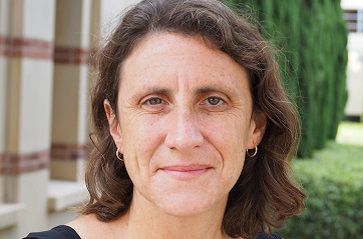Prepare to go back in cosmic time at 132nd Faculty Research Lecture

UCLA professor Alice Shapley
Join the journey: The Faculty Research Lecture is free to attend online, but advance registration is required. Visit the website to register for a link. UCLA will publish a video of the lecture on the event website after the lecture.
In just the past few days, observers have marveled at the very first images produced by the James Webb Space Telescope, the powerful orbital observatory launched by NASA in December. The space agency is touting the photos as the sharpest at infrared wavelengths ever taken by a space telescope.
Among the first scientists who will be able to study data from the telescope is UCLA astronomy professor Alice Shapley.
Shapley’s research on how galaxies form and evolve is helping to answer fundamental questions about our galaxy’s very existence. On May 17, she will take her audience back through cosmic time — and peer into the future of her field — as she delivers UCLA’s 132nd Faculty Research Lecture. The talk will be broadcast online through Zoom at 4 p.m., with a live Q&A to follow.
In her work, Shapley uses large ground-based telescopes and space-based facilities to collect optical and infrared images and spectra of distant galaxies observed in the early universe. She has led large observing programs using the Keck Observatory in Hawaii and the Hubble Space Telescope.
In advance of her lecture, Shapley answered questions by email about her lifelong love of astronomy and why she and her peers are at an exciting juncture in understanding how galaxies form.
What attracted you to astronomy?
As early as kindergarten, I remember being fascinated by different kinds of stars, like red giants and white dwarfs. In a fifth grade science class, we watched a film strip about these mysterious objects called quasars that were so far away that it took light billions of years to travel from them to us. I learned then that astronomers were using quasars to look back in time. I thought that this link between time and distance — through the speed of light — was the coolest thing ever.
When I visited graduate schools in California in 1997, it was clear that the field of galaxy formation was one of the most exciting things going on, and that the Keck Observatory would be a unique facility for studying galaxies. After deciding to go to Caltech to study astronomy, I haven’t looked back.
What excites you most about the field?
The study of galaxy formation and evolution touches on the very deepest question possible: “Where did we — meaning the Milky Way galaxy — come from?” I love the fundamental nature of that question.
I also think that there is a lot of beauty in astronomical data, such as the exquisite images of galaxies from the Hubble Space Telescope, and in the spectral features we measure by dispersing light into its constituent wavelengths. Also interesting is the fact that the imaging and spectroscopic data we collect contain important clues about the nature of galaxies but require us to figure out how to decode our measurements into real physical quantities.
What was your reaction to being selected to give the Faculty Research Lecture?
There may have been a few — OK, many — yelps of joy and excitement! I was so thrilled, humbled and honored.
What do you hope the audience takes away from your lecture?
I hope the audience gains an appreciation of how astronomers use light to peer back billions of years through cosmic time.
I hope viewers realize that when you look at a picture of a galaxy, it’s interesting not only to describe what’s here today, but also to try to understand how it came to be and to appreciate the power of astronomical spectroscopy for unlocking the mysteries of how galaxies form and evolve in the universe.
And I hope they realize what an exciting juncture astronomers — and all humans — find ourselves at right now, with the launch of the Webb telescope. It promises a transformational boost in sensitivity, along with the power to collect not only beautiful images but breathtakingly detailed spectra. These spectra will provide an unprecedented window into the physics of how planets, stars and galaxies form in the universe.
This article originally appeared in the UCLA Newsroom. For more news and updates from the UCLA College, visit college.ucla.edu/news.


 UCLA
UCLA
 Image credit: Stephanie Diani
Image credit: Stephanie Diani